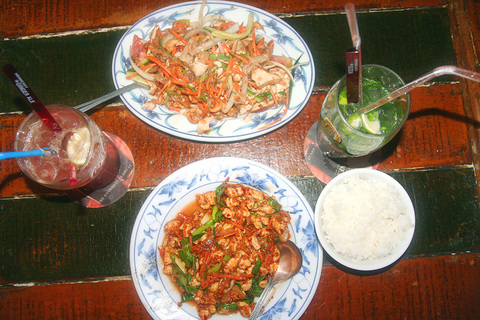It was a Sunday afternoon in Kenting (墾丁) and tourists were fleeing the Pingtung County (屏東縣) hotspot to avoid getting trapped by the approaching typhoon.
A perfect opportunity, it seemed, had presented itself to check out Warung Didi. On several previous visits the Taipei Times had been rebuffed by the famed purveyor of “a world of exotic cuisines,” as it was fully booked.
So this time around we did as we were told and called promptly at 4pm for reservations that night. The phone was constantly engaged and the restaurant was reserved by the time we got through an hour later.

PHOTO: JULES QUARTLY, TAIPEI TIMES
Fortunately (to cut a long review short) there had been a cancellation at 11:20pm. Last orders would be ours. And that is how we eventually came to review the culinary landmark founded by Di Di Yi (易迪迪) some 14 years ago.
The drinks list was a good start, with a thoughtful range of cocktails, beers, wines and nonalcoholic beverages. Though our mojito and mai tai (dubbed “my tai tai,”) were served up quickly, at full strength and with fresh ingredients, their arrival in Boddingtons and Coca-Cola glasses was a little surprising.
The menu was conveniently divided into sections, such as “the chicken coop” for poultry dishes, “soup pot,” “ok corral” for beef, seafood was “the waterfront.”
We plumped for Thai boneless chicken in basil sauce and Patpong chicken salad with shrimp dressing. They were zesty affairs but a degree too hot for our taste.
Most of the main dishes were priced from NT$250 to NT$340 and the cheesecake (NT$100), made daily, was wickedly rich, piqued by lemon and caramelized on top. Clearly, fresh food served in fair-sized portions, at a reasonable cost is one of the reasons for Warung Didi's popularity.
Atmosphere is also essential. If a place feels good you want to go back. Located off the high street and near the beach, Warung Didi was bathed in fairy lights, miniature red lanterns and ambient music. The interior was tastefully decorated in wood, with Indian/Aboriginal designs and an eclectic mix of old prints and batik paintings.

Nov. 11 to Nov. 17 People may call Taipei a “living hell for pedestrians,” but back in the 1960s and 1970s, citizens were even discouraged from crossing major roads on foot. And there weren’t crosswalks or pedestrian signals at busy intersections. A 1978 editorial in the China Times (中國時報) reflected the government’s car-centric attitude: “Pedestrians too often risk their lives to compete with vehicles over road use instead of using an overpass. If they get hit by a car, who can they blame?” Taipei’s car traffic was growing exponentially during the 1960s, and along with it the frequency of accidents. The policy

Hourglass-shaped sex toys casually glide along a conveyor belt through an airy new store in Tokyo, the latest attempt by Japanese manufacturer Tenga to sell adult products without the shame that is often attached. At first glance it’s not even obvious that the sleek, colorful products on display are Japan’s favorite sex toys for men, but the store has drawn a stream of couples and tourists since opening this year. “Its openness surprised me,” said customer Masafumi Kawasaki, 45, “and made me a bit embarrassed that I’d had a ‘naughty’ image” of the company. I might have thought this was some kind

What first caught my eye when I entered the 921 Earthquake Museum was a yellow band running at an angle across the floor toward a pile of exposed soil. This marks the line where, in the early morning hours of Sept. 21, 1999, a massive magnitude 7.3 earthquake raised the earth over two meters along one side of the Chelungpu Fault (車籠埔斷層). The museum’s first gallery, named after this fault, takes visitors on a journey along its length, from the spot right in front of them, where the uplift is visible in the exposed soil, all the way to the farthest

The room glows vibrant pink, the floor flooded with hundreds of tiny pink marbles. As I approach the two chairs and a plush baroque sofa of matching fuchsia, what at first appears to be a scene of domestic bliss reveals itself to be anything but as gnarled metal nails and sharp spikes protrude from the cushions. An eerie cutout of a woman recoils into the armrest. This mixed-media installation captures generations of female anguish in Yun Suknam’s native South Korea, reflecting her observations and lived experience of the subjugated and serviceable housewife. The marbles are the mother’s sweat and tears,